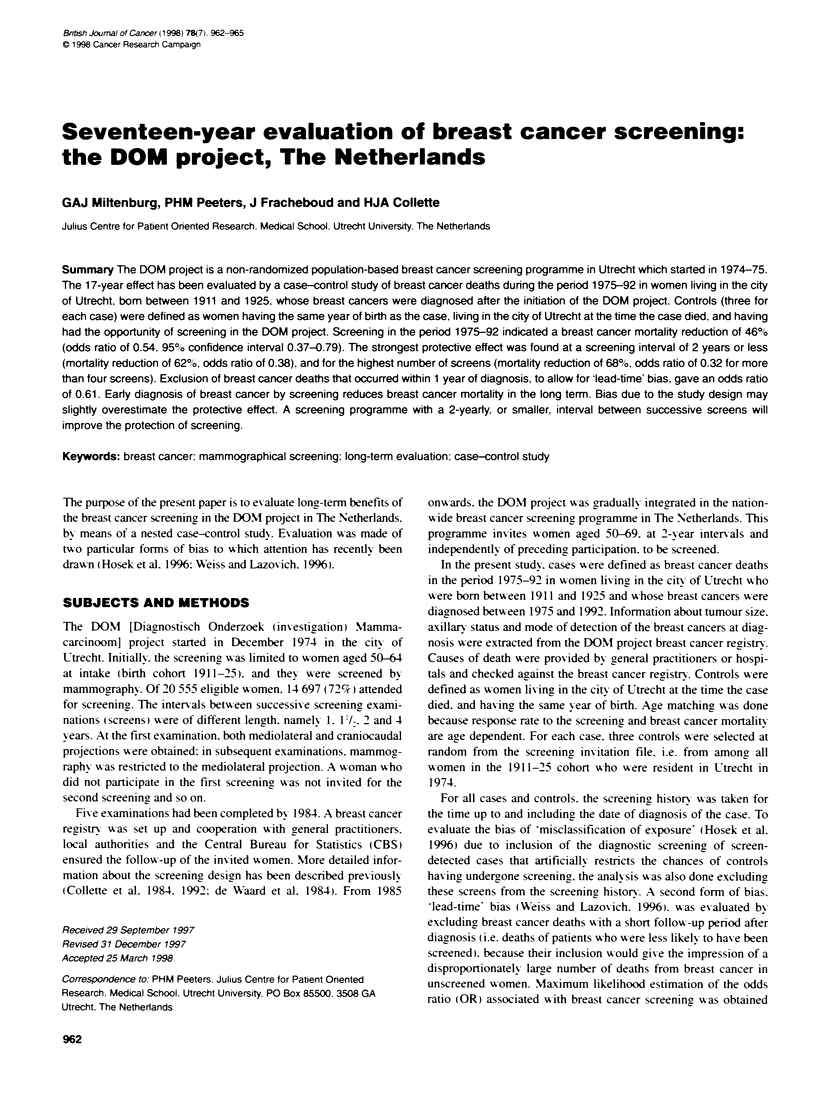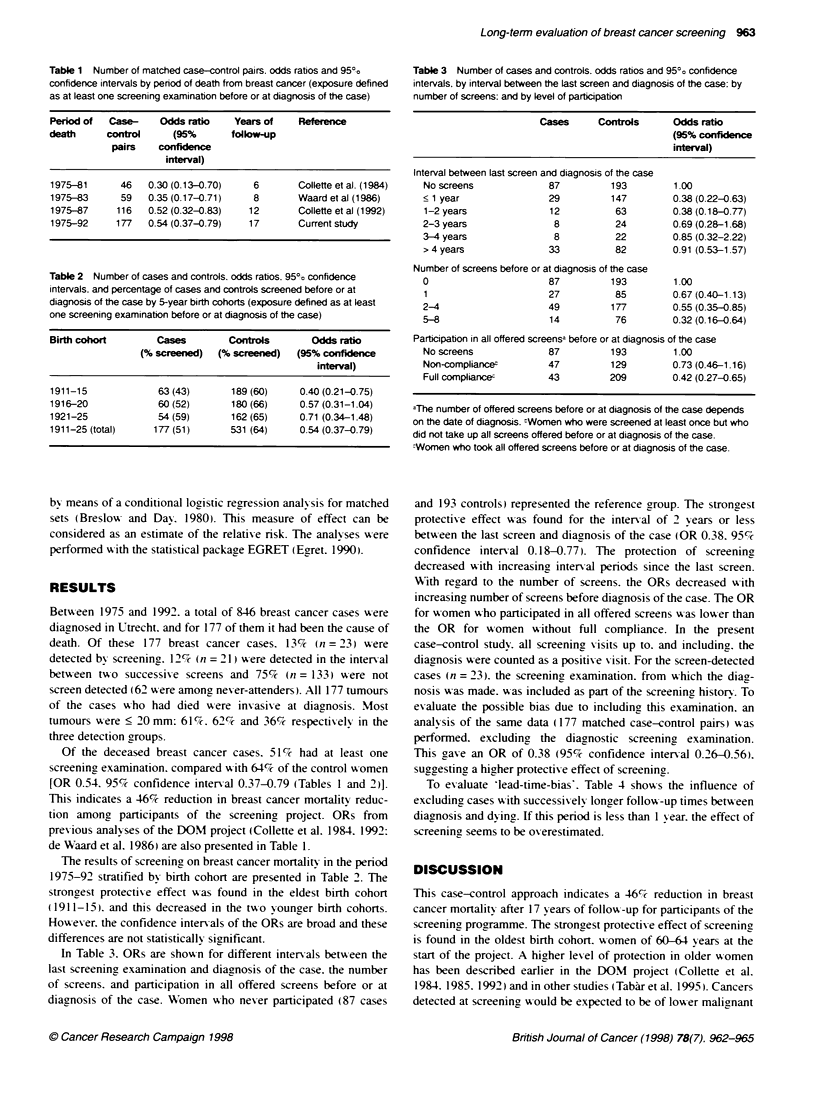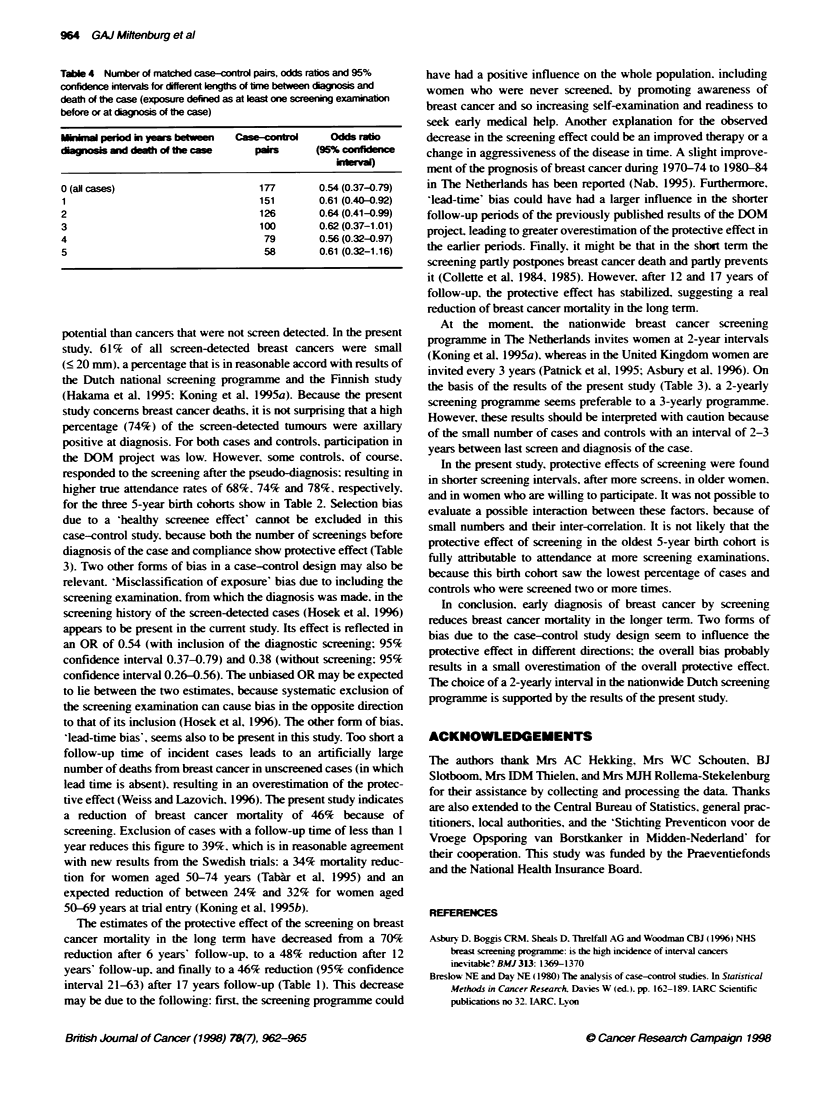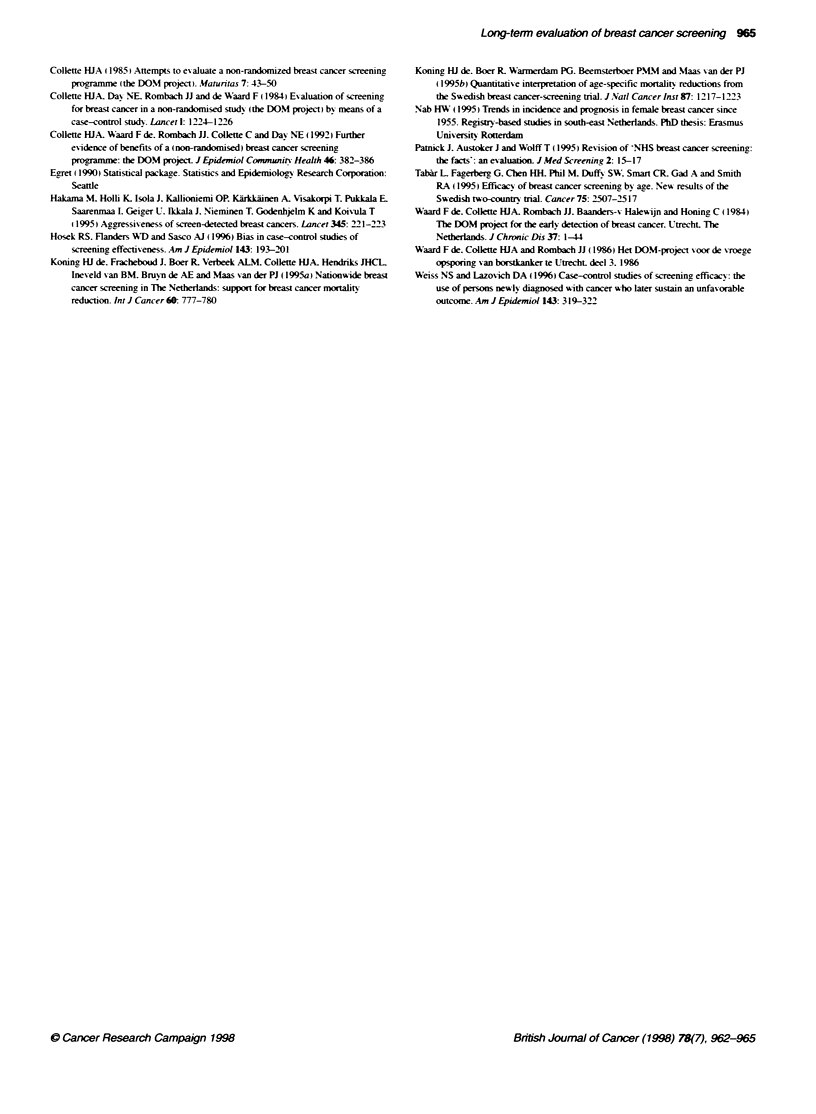Abstract
The DOM project is a non-randomized population-based breast cancer screening programme in Utrecht which started in 1974-75. The 17-year effect has been evaluated by a case-control study of breast cancer deaths during the period 1975-92 in women living in the city of Utrecht, born between 1911 and 1925, whose breast cancers were diagnosed after the initiation of the DOM project. Controls (three for each case) were defined as women having the same year of birth as the case, living in the city of Utrecht at the time the case died, and having had the opportunity of screening in the DOM project. Screening in the period 1975-92 indicated a breast cancer mortality reduction of 46% (odds ratio of 0.54, 95% confidence interval 0.37-0.79). The strongest protective effect was found at a screening interval of 2 years or less (mortality reduction of 62%, odds ratio of 0.38), and for the highest number of screens (mortality reduction of 68%, odds ratio of 0.32 for more than four screens). Exclusion of breast cancer deaths that occurred within 1 year of diagnosis, to allow for 'lead-time' bias, gave an odds ratio of 0.61. Early diagnosis of breast cancer by screening reduces breast cancer mortality in the long term. Bias due to the study design may slightly overestimate the protective effect. A screening programme with a 2-yearly, or smaller, interval between successive screens will improve the protection of screening.
Full text
PDF



Selected References
These references are in PubMed. This may not be the complete list of references from this article.
- Asbury D., Boggis C. R., Sheals D., Threlfall A. G., Woodman C. B. NHS breast screening programme: is the high incidence of interval cancers inevitable? BMJ. 1996 Nov 30;313(7069):1369–1370. doi: 10.1136/bmj.313.7069.1369. [DOI] [PMC free article] [PubMed] [Google Scholar]
- Collette C., Collette H. J., Fracheboud J., Slotboom B. J., de Waard F. Evaluation of a breast cancer screening programme--the DOM project. Eur J Cancer. 1992;28A(12):1985–1988. doi: 10.1016/0959-8049(92)90244-v. [DOI] [PubMed] [Google Scholar]
- Collette H. J. Attempts to evaluate a non-randomized breast cancer screening programme (the 'DOM-project'). Maturitas. 1985 May;7(1):43–50. doi: 10.1016/0378-5122(85)90033-7. [DOI] [PubMed] [Google Scholar]
- Collette H. J., Day N. E., Rombach J. J., de Waard F. Evaluation of screening for breast cancer in a non-randomised study (the DOM project) by means of a case-control study. Lancet. 1984 Jun 2;1(8388):1224–1226. doi: 10.1016/s0140-6736(84)91704-5. [DOI] [PubMed] [Google Scholar]
- Collette H. J., de Waard F., Rombach J. J., Collette C., Day N. E. Further evidence of benefits of a (non-randomised) breast cancer screening programme: the DOM project. J Epidemiol Community Health. 1992 Aug;46(4):382–386. doi: 10.1136/jech.46.4.382. [DOI] [PMC free article] [PubMed] [Google Scholar]
- De Koning H. J., Fracheboud J., Boer R., Verbeek A. L., Collette H. J., Hendriks J. H., van Ineveld B. M., de Bruyn A. E., van der Maas P. J. Nation-wide breast cancer screening in The Netherlands: support for breast-cancer mortality reduction. National Evaluation Team for Breast Cancer Screening (NETB). Int J Cancer. 1995 Mar 16;60(6):777–780. doi: 10.1002/ijc.2910600608. [DOI] [PubMed] [Google Scholar]
- Hosek R. S., Flanders W. D., Sasco A. J. Bias in case-control studies of screening effectiveness. Am J Epidemiol. 1996 Jan 15;143(2):193–201. doi: 10.1093/oxfordjournals.aje.a008729. [DOI] [PubMed] [Google Scholar]
- Patnick J., Austoker J., Wolff T. Revision of "NHS breast screening: the facts": an evaluation. J Med Screen. 1995;2(1):15–17. doi: 10.1177/096914139500200105. [DOI] [PubMed] [Google Scholar]
- Tabar L., Fagerberg G., Chen H. H., Duffy S. W., Smart C. R., Gad A., Smith R. A. Efficacy of breast cancer screening by age. New results from the Swedish Two-County Trial. Cancer. 1995 May 15;75(10):2507–2517. doi: 10.1002/1097-0142(19950515)75:10<2507::aid-cncr2820751017>3.0.co;2-h. [DOI] [PubMed] [Google Scholar]
- Weiss N. S., Lazovich D. Case-control studies of screening efficacy: the use of persons newly diagnosed with cancer who later sustain an unfavorable outcome. Am J Epidemiol. 1996 Feb 15;143(4):319–322. [PubMed] [Google Scholar]
- de Koning H. J., Boer R., Warmerdam P. G., Beemsterboer P. M., van der Maas P. J. Quantitative interpretation of age-specific mortality reductions from the Swedish breast cancer-screening trials. J Natl Cancer Inst. 1995 Aug 16;87(16):1217–1223. doi: 10.1093/jnci/87.16.1217. [DOI] [PubMed] [Google Scholar]
- de Waard F., Collette H. J., Rombach J. J., Baanders-van Halewijn E. A., Honing C. The DOM project for the early detection of breast cancer, Utrecht, The Netherlands. J Chronic Dis. 1984;37(1):1–44. doi: 10.1016/0021-9681(84)90123-1. [DOI] [PubMed] [Google Scholar]


